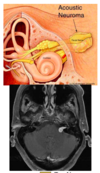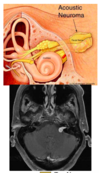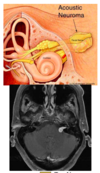L14: Pathologies of the peripheral vestibular system, assessment practises for differential diagnosis Flashcards
What are 3 key symptoms to ‘listen’ for or ask about to differentiate pathologies?
Can use closed questions here:
- Dizziness
- Type
- Duration (eg. can have multiples of dizziness V1 and V2)
- Associated auditory symptoms
_____ is the 2nd most common cause of vertigo.
Vestibular Neuritis
What is vestibular neuritis?
Acute inflammation of the vestibular nerve (CN VIII)

What often precedes vestibular neuritis?
a viral infection possibly the herpes virus
What is the superior division of the vestibular nerve?
Utricle and anterior/superior and horizontal canals
What is the inferior division of the vestibular nerve?
Saccule and posterior / inferior canal
What is the type of dizziness in vestibular neuronitis during the acute phase?
acute onset of prolonged rotary vertigo
Acute: spinning and can’t make it stop
What is the duration of vestibular neuronitis during the acute phase?
>1 but <4 days
At least a day but gone by 4 days
What are the provoking positions in vestibular neuronitis during the acute phase?
exacerbated by head movement… but present continuously (acute phase‐ has baseline level of symptoms)
Trying to activate vestibular system
What are the auditory symptoms in vestibular neuronitis during the acute phase?
no hearing loss; tinnitus; aural fullness (unless only inferior division – hearing loss)
What are the associated symptoms in vestibular neuronitis during the acute phase?
postural imbalance / nausea
Trouble walking but able to use limbs (eg. to crawl to bathroom to vomit)
What are the visual observations in vestibular neuronitis during the acute phase?
Nystagmus ‐ horizontal‐rotary nystagmus beating away from affected ear (may not be felt or called jumpy eyes by the patient)… more detail in objective assessment.
Which way does the nystagmus beat in vestibular neuronitis during the acute phase?
away from affected ear
What is Alexander’s Law?
individuals with nystagmus, the amplitude of the nystagmus increases when the eye moves in the direction of the fast phase (saccade). It is manifested during spontaneous nystagmus in a patient with a vestibular lesion.
Eg. beating to L and then look to the L you would get more beating than if you looked to the R
What is the type of dizziness in vestibular neuronitis after the acute phase?
‐ giddiness but will be symptom free at rest
What is the duration of vestibular neuronitis after the acute phase?
constant… as recovers / intermittent
What are the provoking positions/movements in vestibular neuronitis after the acute phase?
head movements
What are the auditory symptoms in vestibular neuronitis after the acute phase?
‐ ISQ to original symptoms
What are the associated symptoms in vestibular neuronitis after the acute phase?
postural imbalance / nausea / fatigue / jumpy vision – blurred with movement
Do you see a nystagmus in vestibular neuronitis after the acute phase?
May or may not see an ongoing horizontal nystagmus
What is vestibular labyrinthitis?
Presentation is identical to neuritis however with the additional symptom of hearing loss (lesion site = labyrinth)

How does vestibular labyrinthitis differ from vestibular neuronitis?
Presentation is identical to neuritis however with the additional symptom of hearing loss (lesion site = labyrinth) Sudden hearing loss (even if its recovered)

Where is the lesion in vestibular labyrinthitis?
Labyrinth

What is Meniere’s Disease and Endolymphatic Hydrops?
- Disorder of inner ear function
- Two variants
- vestibular
- cochlear
When are the onset of Meniere’s Disease and Endolymphatic Hydrops?
Usually has onset in the 4th – 6th decades

Meniere’s Disease and Endolymphatic Hydrops up to 25% ______ (unilateral/bilateral)
bilateral

What happens when there is an increase in fluid?
Increase of fluid at the perilymph –> over loads –> presses the hair cells (sac is not draining properly –> goes away)

What is the type of dizziness in Meniere’s Disease during the acute phase?
acute onset of prolonged rotary vertigo





